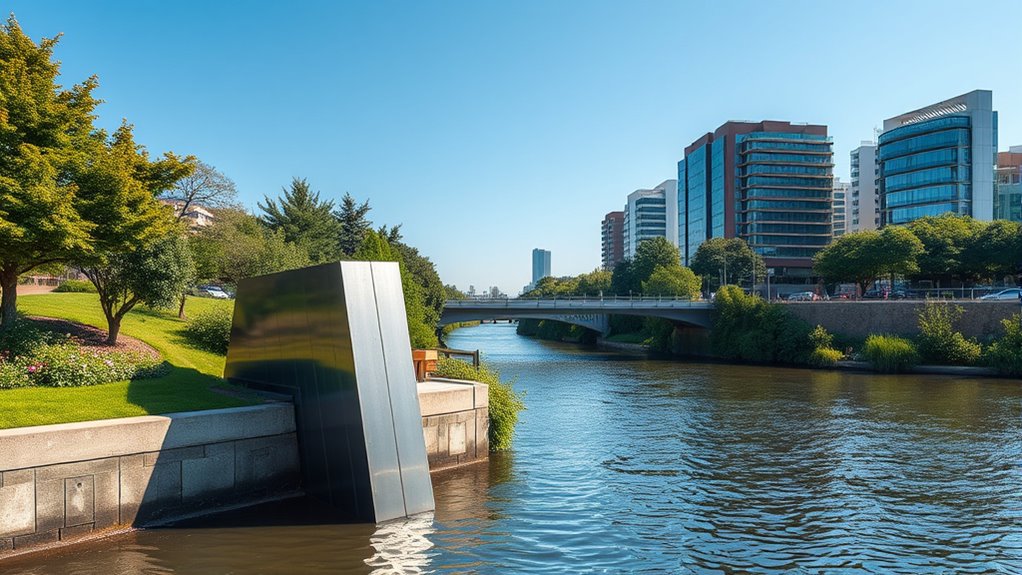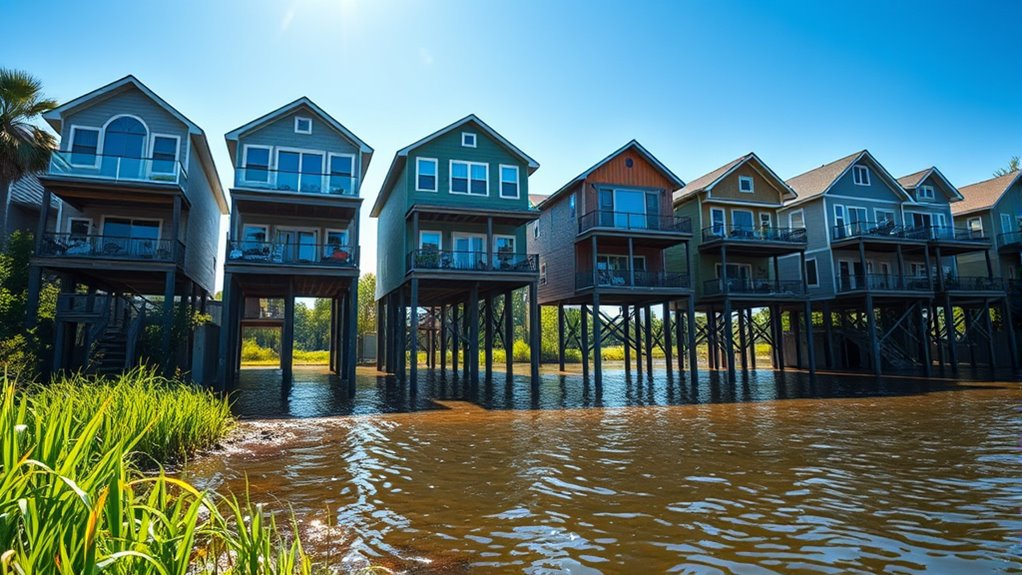To keep water out of your property during floods, implement various mitigation techniques. Start by elevating your building above the Base Flood Elevation. Use watertight doors and windows along with waterproof sealants to prevent water intrusion. Install flood vents to minimize hydrostatic pressure. Temporary barriers like sandbags can divert water effectively, while proper drainage systems for floodwalls will enhance protection. By taking these proactive measures, you can better safeguard your home from flood damage, so keep exploring for more strategies.
Key Takeaways
- Install watertight doors and windows to prevent water entry during flooding events.
- Utilize floodproofing methods, such as dry floodproofing with waterproof sealants, to safeguard structures.
- Elevate properties above the Base Flood Elevation to reduce flood damage risk.
- Implement flood vents to minimize hydrostatic pressure and protect structural integrity.
- Construct temporary barriers like sandbags to effectively divert floodwaters away from buildings.
Your Action Plan for Flooding

When a flood threatens your area, having a solid action plan can make all the difference. First, sign up for community emergency alert systems to stay updated on flood risks and receive crucial instructions.
Create an emergency to-go kit filled with essentials and establish clear evacuation routes and meeting points for your household. This guarantees everyone knows how to protect your home and get to safety quickly. Additionally, ensure that you have open communication with your family members about their feelings regarding the situation to foster emotional support during stressful times. Being prepared can strengthen community resilience during crises. Furthermore, consider having a power of attorney designated to make important decisions during emergencies. Animals can provide emotional support during stressful situations, making it beneficial to consider pet therapy options for family members who may need additional comfort.
Assemble an emergency kit and plan evacuation routes to ensure your family can stay safe during a flood.
Store valuable items on the highest floor and make copies of important documents to prevent water damage. Additionally, consider financial planning for emergencies to ensure you have the resources needed for recovery.
After the flood, approach your home cautiously, checking for electrical hazards and structural damage. Monitor for signs of mold growth, as standing water can lead to harmful bacteria and viruses if not addressed promptly. It’s essential to seek professional counseling if the emotional impact of the flood is overwhelming for you or your family.
Flood Prevention and Mitigation

To effectively prevent flooding, you need to assess your flood risk using tools like ClimateCheck reports and FEMA maps. Once you understand your property’s vulnerability, you can implement effective floodproofing methods, such as wet and dry techniques, to safeguard your home. Additionally, a thorough energy efficiency evaluation can help you identify areas that may contribute to excess water runoff. Implementing integrated pest management practices in your landscaping can also enhance soil health, reducing runoff. Don’t forget that community collaboration, like restoring local ecosystems, plays an essential role in enhancing flood resilience for everyone. Additionally, considering eco-friendly practices can further contribute to sustainable flood mitigation efforts. Utilizing renewable energy solutions can also help power flood mitigation systems, reducing reliance on traditional energy sources. Engaging in biodiversity conservation can strengthen local ecosystems, making them more resilient to flooding and other environmental challenges.
Assessing Flood Risk
How can you effectively evaluate flood risk for your property? Start by utilizing ClimateCheck property reports and FEMA flood maps to pinpoint your specific vulnerabilities. Understanding the Base Flood Elevation (BFE) is essential; it indicates the minimum elevation your structures should meet to minimize flood damage. Additionally, proper insulation upgrades can help mitigate moisture infiltration during flood events. Ensure that your property’s elevation complies with local building codes to enhance overall safety. A thorough assessment of your surroundings will also reveal high-traffic areas that may be more susceptible to flooding. Consider the impact of air quality management methods, such as using air purifiers, which can help reduce indoor humidity levels and further protect your property during flood events.
If your property is in a flood-prone area, consider installing flood vents, especially in FEMA-designated zones, to equalize hydrostatic pressure and prevent structural failure during flooding events. Regular maintenance is also key—make sure to clear your gutters and direct downspouts away from your foundation. Additionally, understanding the refrigeration cycle can help identify potential risks associated with moisture and humidity levels in your home.
Effective Floodproofing Methods
Evaluating flood risk is just the first step in safeguarding your property; implementing effective floodproofing methods is equally important.
You can start by considering dry flood-proofing techniques, such as installing watertight doors, windows, and waterproof sealants, which effectively prevent water from entering your building. Energy-efficient heat pumps can also be utilized to maintain climate control in the event of a flood, ensuring comfort and safety for occupants. Regular maintenance of these systems is crucial for optimal indoor air quality, especially in challenging weather conditions. Creating a safe living environment for seniors during floods is essential to their well-being. Additionally, understanding the average time to build a tiny house can help in planning for emergency shelters in flood-prone areas, ensuring timely construction and community support.
Flood vents are also essential; they reduce hydrostatic pressure against your foundation, minimizing structural damage during flooding.
Elevating your home above the Base Flood Elevation (BFE) using piers or columns is another critical strategy.
Additionally, temporary floodwalls can be constructed around your property to hold back floodwaters, but be sure to include proper drainage systems to manage water escape during non-flood conditions.
These methods can considerably enhance your flood resilience. Incorporating solar-powered solutions can also provide sustainable energy for managing drainage systems during a flood event.
Community Collaboration Strategies
While individual efforts to mitigate flood risks are important, community collaboration is essential for effective flood prevention and preparedness. By working together, you can enhance flood resilience through strategies like restoring ecosystems and creating green spaces. Engaging local governments can lead to grant programs that support flood mitigation projects. Additionally, creating supportive communities can further strengthen the collective response to flooding challenges. An effective method to engage community members is to provide education on the psychological and cognitive benefits of participating in local initiatives. Communities that join together often have enhanced flood resilience, which can significantly reduce the impacts of flooding. Moreover, fostering efficient general ledger coding practices in community financial management can help ensure transparency and accountability in funding allocation for flood mitigation efforts. Understanding the importance of early intervention in community planning can lead to more effective responses to flooding.
Here’s a quick overview of effective community collaboration strategies:
| Strategy | Benefits | Action Steps |
|---|---|---|
| Restore Ecosystems | Enhances flood resilience | Organize local restoration events |
| Reduce Stormwater Runoff | Lowers flood risk | Implement green infrastructure |
| Engage Local Governments | Secures funding for projects | Schedule regular community meetings |
Together, these actions can notably decrease flood damage costs and improve recovery outcomes.
Required Flood Mitigation

What steps can you take to protect your property from flooding? First, consider the required flood mitigation techniques in your area. If you live in a FEMA-designated flood zone, you might need to install flood openings that allow water to flow through your structure, minimizing structural damage.
Implementing dry floodproofing methods, such as watertight doors and waterproof sealants, is essential to prevent water entry into your building. You may also need to elevate your property to meet Design Flood Elevation standards.
Additionally, installing flood vents can help reduce hydrostatic pressure, preventing structural failure during floods. In some cases, constructing floodwalls could be necessary, but remember to obtain local regulatory approvals before starting such projects.
Protect your investment!
Structural Flood Mitigation Techniques

When it comes to protecting your property from flooding, understanding structural flood mitigation techniques is essential.
You can choose between wet floodproofing methods that allow water to flow through and dry floodproofing solutions that keep it out entirely.
Additionally, floodwall construction guidelines provide important strategies for managing floodwaters effectively.
Wet Floodproofing Methods
Wet floodproofing methods provide an effective solution for minimizing flood damage in areas susceptible to shallow flooding.
By designing structures with flood openings, water can flow through, reducing the potential for significant damage during flooding events. This technique is particularly useful in flood zones where the structural integrity of your building isn’t at serious risk.
FEMA mandates wet floodproofing in certain areas to guarantee compliance with regulations aimed at reducing flood damage risks. Properly installed flood vents help equalize hydrostatic pressure, lowering the chances of structural failure.
Plus, wet floodproofing is a cost-effective alternative to dry floodproofing since it doesn’t require complete sealing against water intrusion, which cuts down on both construction and maintenance costs.
Dry Floodproofing Solutions
While floodwaters can pose significant threats to buildings, dry floodproofing solutions provide a robust defense against water intrusion. This structural mitigation technique uses watertight doors, windows, and waterproof sealants to prevent water from entering your building, making it especially effective in areas with a lower risk of flooding.
Proper installation often requires you to comply with local building codes and may involve obtaining permits. Integrating flood vents is essential, as they help equalize hydrostatic pressure, minimizing structural damage during flood events.
Dry floodproofing can also be a cost-effective choice for existing structures, particularly when paired with other strategies like elevating critical utilities above flood levels and ensuring a reliable drainage system is in place.
Floodwall Construction Guidelines
To effectively protect your property from flooding, understanding floodwall construction guidelines is essential. Floodwalls act as temporary barriers to hold back flood water, but they need a proper drainage system to function effectively when not in use.
Before you start, check with your local government for any permits or regulations that may apply. Proper design is vital; floodwalls must withstand hydrostatic pressure to maintain their effectiveness and protect your building’s structural integrity.
Additionally, consider local topography and drainage patterns in your planning to avoid unintended water accumulation that could increase flood risk elsewhere.
Elevating Buildings for Enhanced Safety

Elevating buildings is crucial for enhancing safety in flood-prone areas, as it considerably reduces the risk of flood damage. By raising structures above the Base Flood Elevation (BFE), you guarantee compliance with local regulations and long-term safety.
New constructions often need to meet Design Flood Elevation standards, while existing buildings can be elevated using piers, columns, or pilings. This process not only protects essential utilities like HVAC systems but also leads to lower repair costs and quicker recovery after a flood.
Additionally, homes that are elevated can qualify for lower National Flood Insurance premiums, making it a financially smart choice. Elevating buildings isn’t just about safety—it’s about safeguarding your investment.
Temporary Barriers and Floodwalls

Flood protection relies heavily on effective solutions like temporary barriers and floodwalls.
Temporary barriers, such as sandbags, can effectively divert floodwaters, holding back water up to two feet deep when properly installed.
Floodwalls, engineered structures, keep floodwaters out of specific areas, but they may require local permits before construction.
To function effectively, floodwalls need proper drainage systems, allowing water to escape when it’s not flooding.
- You can keep your loved ones safe.
- Protect your home from devastating water damage.
- Secure your community’s future against flooding.
Incorporating flood vents with floodwalls helps minimize structural damage by reducing hydrostatic pressure.
When you take these steps, you’re not just building barriers; you’re creating peace of mind.
Recovering From Flood Damage

Recovering from flood damage can feel overwhelming, but taking the right steps can make the process smoother. Start by documenting all damage with photos, which supports your insurance claims and expedites recovery.
Prioritize safety; check for structural integrity and electrical hazards before entering any flooded area. Wear protective gear to shield yourself from contaminated water and hazardous materials.
As you clean up, monitor for mold growth, since standing water can promote bacteria and mold within 24 hours. File your insurance claims promptly, keeping detailed records of all communications with the insurance company.
With careful attention, you can manage recovering from flood damage and restore your space, allowing water to flow freely away from your home in the future.
Frequently Asked Questions
What Are the Techniques of Flood Mitigation?
When it comes to flood mitigation, you’ve got several techniques to contemplate. You can elevate your building above the Base Flood Elevation to prevent water damage.
Dry floodproofing keeps water out with watertight barriers, while wet floodproofing allows water to flow through, reducing pressure.
Additionally, installing flood vents and constructing temporary floodwalls can further protect your property. Each method has its benefits, so choose what best suits your situation and local regulations.
How to Keep Water Out of House During Flood?
When rain pours like a waterfall, you don’t want your home to become a swimming pool. To keep water out during a flood, elevate your house above the Base Flood Elevation.
Install flood vents to let water flow through safely, minimizing damage. Use waterproof sealants on basement walls and doors to block moisture.
Build temporary floodwalls or use sandbags as barriers, and don’t forget to clear gutters regularly for proper drainage!
What Are the Mitigation Strategies for Floods?
When it comes to flood mitigation strategies, you’ve got several options.
Elevating your home above the Base Flood Elevation (BFE) is a smart move, as it helps prevent water damage. You might also consider installing flood vents, which equalize pressure and reduce structural risk.
Additionally, dry flood-proofing techniques using watertight barriers can keep water out effectively.
Temporary floodwalls are another option, but make sure you have proper drainage and check local regulations first.
What Are 3 Measures Used to Control Flooding?
Picture your home standing tall against nature’s fury, safe from rising waters.
To control flooding, you can elevate your building, raising it above potential water levels. Installing floodwalls creates a sturdy barrier, keeping floodwaters at bay.
Additionally, using flood vents helps equalize pressure, protecting your structure from damage.
With these three measures, you’re not just safeguarding your property but also ensuring peace of mind when storms loom on the horizon.
Conclusion
To conclude, flood mitigation is like building a strong dam against the rising tide of challenges. By taking proactive steps to prevent flooding, such as elevating buildings and using temporary barriers, you’re not just protecting your property; you’re safeguarding your peace of mind. Remember, it’s all about preparation and resilience. With the right strategies in place, you can weather any storm and come out stronger on the other side. Stay vigilant and take action!










